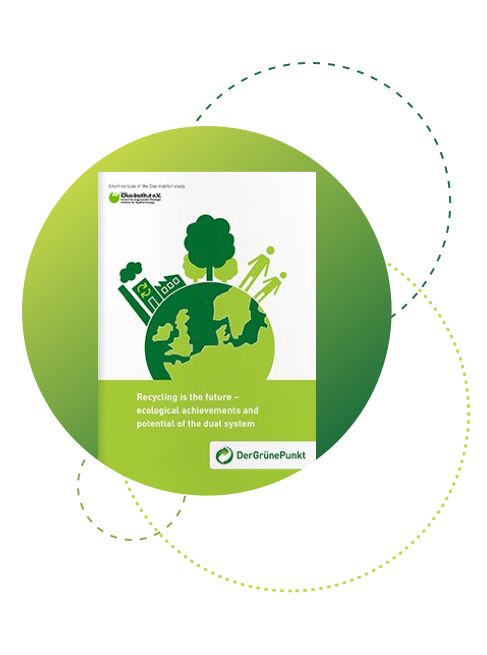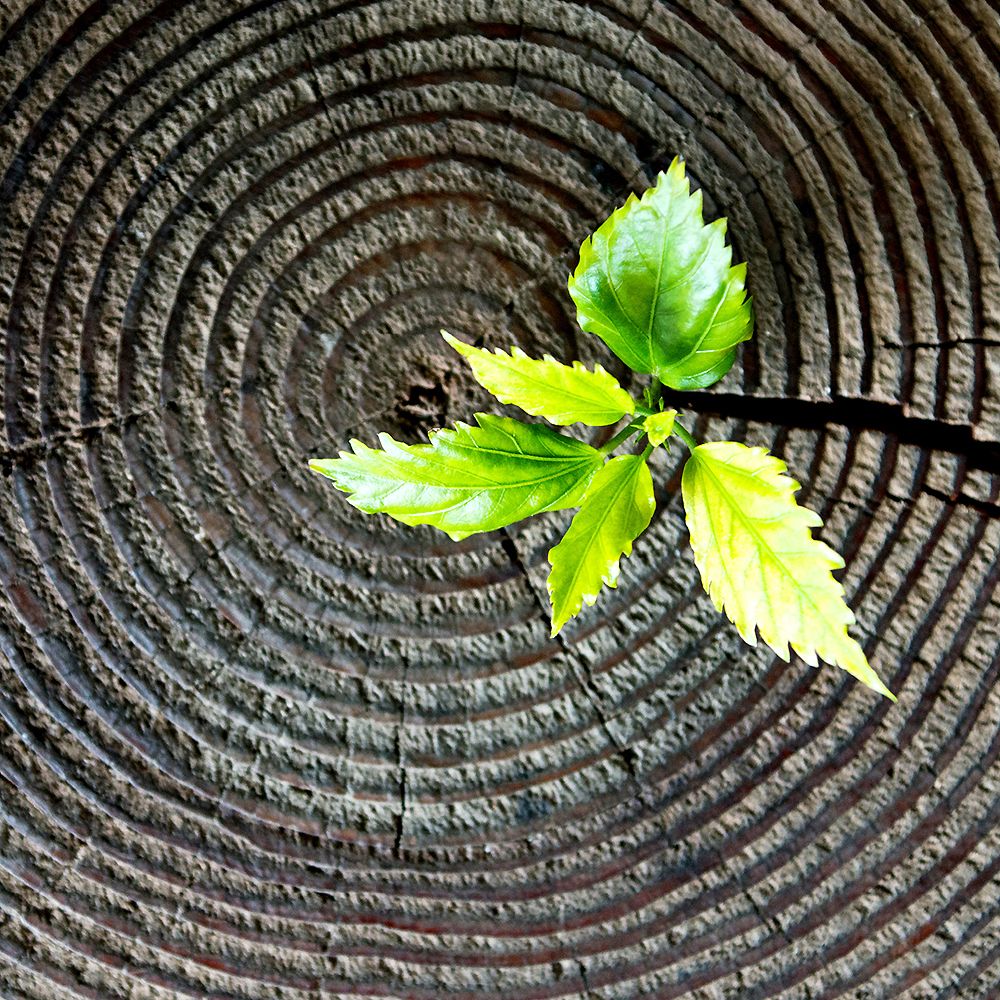"The dual system makes an important contribution towards protecting the climate and the natural environment. Nonetheless, there is plenty of potential as yet untapped, which can be accessed by opting for the right strategic agenda."
The study from Öko-Institut maps out and quantifies the benefits of the dual system for collecting and recovering sales packaging. One thing emerges quite clearly: there is additional major potential in the dual system waiting to be harnessed. By purposeful upgrading and optimization, this potential can be effectively unlocked and the benefits of the dual system increased still further.

ACHIEVEMENTS
This applies particularly to lightweight packaging made of plastics, metals and composites. Their collection and recovery by the dual system alone reduces environmental impact today by 1.9 million tons of CO2 equivalents per annum. The total contribution towards climate protection made by recycling lightweight packaging, glass, paper, cardboard and carton is running at 3.1 million tons of CO2 equivalents.
Recycling lightweight packaging reduces the environmental impact in numerous respects. Soil acidification is reduced just as significantly as the impact caused by phosphate equivalents, known as terrestrial eutrophication. In addition, the dual system enables the reduced consumption of fossil fuels, such as coal and oil.
The recycling of lightweight packaging makes an overproportional contribution towards climate protection compared to the recovery of other waste fractions: for example, 19 times more per ton than disposal of the residual waste, most of which is burned in refuse incineration plants. More than half the contribution towards climate protection made by waste recovery is attributable to the dual system.
In terms of the environmental aspects involved, recycling is superior to the processes for energy recovery. This applies particularly to the totality of all environmental criteria, and whenever, in addition to the classical impact categories of the lifecycle assessment, aspects such as resource economy and environmental impact from raw material extraction are also factored in.
OUTLOOK
By increasing the quantities collected, optimizing the separation concept, and deploying a complete-coverage sorting scheme utilizing present-day state-of-the-art technology, the dual system could make an even greater contribution towards protecting the natural environment. This could, given optimal development and inclusion of the credits for glass and paper, cardboard and cartons, add up to more than 4.7 million tons of CO2 equivalents per annum. The expansion of the dual system would also lead to a definite reduction in acidification, eutrophication and the consumption of fossil fuels.
All trends foreseeable at present will cause the superiority of recycling over energy recovery to increase still further in the future. For instance, greener power and heat mixes as part of the energy transition, for instance, will reduce the ecological added value of power and heat generation based on energy recovery.
Higher targets for plastics recycling, easier sorting in households (by introducing the Recyclables Bin, for example), incentives for using packaging materials more amenable to recycling (Design4Recycling), plus security in regard to the requisite capital investments in innovations and technical progress, constitute efficacious levers, particularly in conjunction with each other.
Background
In view of climate change, environmental pollution, population growth and resource-dependency, the transition from a linear to a closed-cycle economy is essential for both ecological and economical reasons. However, as uncontentious as the goal of a closed-cycle economy is in the business community, academia, politics and society as a whole, the road map for achieving it is equally contentious and unclear. When it comes to developing sustainable solutional approaches, the paramount question involved is the efficacy of existing instruments and structures.
Germany is a pioneer when it comes to developing a closed-cycle economy. With the introduction of product responsibility and the creation of the dual system for collecting and recovering packaging waste more than 25 years ago, a road map has been followed that has meanwhile been recognized as being exemplary by many countries inside and outside Europe. Following deregulation to permit competition, the dual system in Germany consists of eleven system operators with Der Grüne Punkt being used far beyond the country’s borders. It is acknowledged as one of the best known trademarks, and symbolizes resource economy and environmental protection.
Look into the future of the dual system
But what has the dual system achieved in Germany since 1990? What benefits does it have for the natural environment and the climate? And above all: what potential can be unlocked by upgrading the system?
These questions have so far been scientifically answered to only a limited extent. What the studies on the dual system have failed to fully illuminate until today was primarily the effects of the situational framework involved – from the extension of product responsibility to other material flows all the way through to increased deployment of renewable energies and the use of better sorting technology – plus their interdependencies.
In its study, Recycling is the future – ecological achievements and potential of the dual system, Öko-Institut has drawn up not only a comprehensive lifecycle assessment in order to determine the extent of both the increase and the decrease of the burden to the climate and the natural environment attributable to the dual system for the collection and recovery of sales packaging in Germany. In the study audited by an independent referee, Öko-Institut also focuses on the future, and adduces relevant scenarios to examine the potential of the dual system. For the first time, this analysis of the scenarios concerned enables important conclusions to be drawn for the political and economic decisions involved.
Approach and methodology
The benefits and potential of the dual system are examined in two steps. First of all, the period from 1990 to 2014 is analyzed in order to determine what contribution the dual system is already making today towards protecting the climate and the natural environment. The status quo (2014) is for this purpose referenced to the waste management sector as it was in 1990, i.e. before the termination of landfilling and before the introduction of the dual system (see Benefits of the dual system ). To enable the potential of a design-enhanced dual system to be estimated up to 2030, political and economic situational frameworks are then varied in three different scenarios, and further foreseeable changes are incorporated in sensitivity analyses.
The method: lifecycle assessment
This examination of the dual system is based on the lifecycle assessment method as laid out in ISO 14040/14044. For the questions addressed by this study, however, the detailed assessment of individual products is replaced by a higher order examination of entire sectors or fields of action, in this case the German dual system.
The study examines both the additional and reduced impact on the environment caused by the collection and recovery or disposal of packaging waste in Germany. The data involved relate to the total quantity collected in the system, and accordingly to the performative capabilities of the entire dual system, comprising collection, sorting and recovery of the materials involved. The focus here lies on lightweight packaging. The study covers the path of the waste from collection at the place of origin (e.g. in households), the sorting and treatment, all the way through to the manufacture of secondary products. Factors incorporated include transportation, externally purchased energy and consumables (e.g. caustic soda for neutralizing the chlorine input in the waste), and the disposal of the waste (e.g. sorting and treating residues).
¹ The ecoinvent database is the leading data system for central acquisition, calculation and management of lifecycle assessment data. It is provided by the Swiss ecoinvent Center. This study has utilized ecoinvent V3.1.
Besides mean values, e.g. for consumption of raw materials and energy, most of them taken from the ecoinvent¹ database, specific data are additionally determined. Some of these data, e.g. on material flows and energy consumption values, come from DSD, and have in these cases been reconciled with experts’ estimates, so as to assure the representative nature of the data for the dual system as a whole.
The criteria: environmental impact categories
For calculating the global warming potential (GWP), the savings and climatic impact are examined in terms of CO2 equivalents, while for the environmental category of acidification (AP) the emissions of acid-forming exhaust gasses are adduced. Eutrophication denotes an excessive amount of nutrient intake, both for bodies of water and for soil. In view of the data available, only the terrestrial eutrophication is examined in this study, and the nutrient emissions are calculated by aggregation of phosphate equivalents. The savings in and consumption of fossil fuels are determined using an indicator called “Acumulated fossil energy demand” (KEAfossil). The KEAfossil is a measure for the total consumption of the energy resources required for providing a product or a service. The total resource consumption entailed by energy consumption is added together here.
